Ranthambore Sightseeing
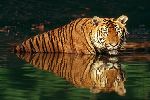
Ranthambore Tiger Reserve and National Park
Originally used as the hunting grounds of Jaipur Maharajas, Ranthambore was coroneted as the Sawai Madhopur Game Sanctuary in the year 1955 by the Government of India. It was declared as the project tiger reserve in 1973 and in 1980, it was raised to the status of National Park. Today, Sawai Man Singh Sanctuary and Keladevi Sanctuary along with Sawai Madhopur Game Sanctuary comprise the widely known Ranthambore Tiger Reservoir, which covers the total area of more than 1334 sq. km.
Ranthambore, renowned as one of the largest national parks in India, is situated at the borders of Thar Desert in Rajasthan. Enclosed by Vindhya Hills on one side and Aravali Hills on the other, and bounded by River Banas to the north and by Chambal River to the south, Ranthambore wildlife sanctuary is spread over the large area of approximately 700 sq. kilometers.
Ranthambore National Park shelters nearly 300 varieties of trees, 272 species of birds, 12 species of reptiles and 30 species of mammals, including the famous Bengal Tiger.
Tigers, Leopards, Desert Cats, Jungle cats, Common Palm Civets, Striped Hyenas, Indian Foxes, Indian Flying Foxes, Jackals, Small Indian Mongoose, Nilgai, Sambar deer, Rufoustailed Hare, Chinkara, Chital, Hanuman langurs, Macaques, Caracals, Indian Wild Boar, Sloth bears, Black bucks, Yellow Bats, Five striped Palm Squirrels, Indian Gerbilles, Indian False Vampires, Indian Mole Rats, Porcupines, Rattles, Long eared Hedgehogs, Snub Nosed Marsh Crocodiles, Tortoise, North Indian Flap Shelled Turtles, Ganga Soft Shelled Turtles, Desert Monitor Lizards, Banded Kraits, Common Kraits, Rat Snakes, Cobras, Indian Pythons, Saw-scaled Vipers Russel's Vipers, Indian Chameleon, Owl, Vulture, Woodpecker, Flycatcher, Heron, Sparrow, Parakeet, Myna, Cuckoo, etc are some of the fauna sighted at Ranthambore.
Ranthambore National Park is open for tourists from 1st October to 30th June every year. Safari rides that last for almost 3 hours are carried out twice a day, 6:30 am and 2:30 pm. You are driven in the territory of tigers either in 6 seater open top gypsy or 20 seater open top canter. The Safari ride costs around 400 to 500 INR. Though photography is allowed in the Reserve, tourists are instructed not to disturb the peace of jungle and abide by the rules for their own safety.
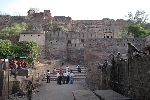
Ranthambore Fort
Ranthambore. Constructed in 944 AD at the top of a steep hill and located at the height of 700 feet above ground level, the Ranthambore Fort is perched in the heart of Ranthambore National Park. Ruined walls, depleted pavilions, aged chhatris and shattered monuments still dazzle in the majestic glory of past grandiose. The noteworthy feature of the fort is its still intact seven enormous gates. An 8th century temple of Lord Ganesh, 12th century temple of Lord Shiva and 13th century shrine of Lord Rama attract thousands of devotees and assist as the venue for the annual fair.
The Ranthambore Fort is believed to be the historical site where the first ‘Jauhar’ of Rajput history was committed by the ladies of Hammir Deva. The present fort of Ranthambore is believed to have been built by the kings of Chauhan Dynasty and it is supposed to be the oldest fort survived in Rajasthan. It was possessed by the great Mughal Emperor Akbar in 16th century. And in 17th century, Mughal gifted the fort to the Kings of Jaipur. The mighty fort spread over the area of 4.5 sq. km. portrays a fantastic fusion of Rajput and Mughal style of architecture.
The top of the fort offers a spectacular view of entire Ranthambore terrain. It is also considered to be a very good station to spot birds and sight wildlife from. A fine pair of binoculars and a powerful camera lenses will turn out to be your true friends here.
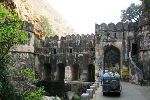
Raj Bagh Ruins
Raj Bag Ruins are the remnants of Raj Bagh Fort that was established by the Rajput Kings who reined Ranthambore in olden days. This fort was used as the resident by Rajput royals back then. Today, the damaged stone outhouses, ruined arches, depleted steps, ravished domes, partly standing walls, shattered towers etc are found on the plateau between Raj Bagh Talao and Padam Talao. Though demolished, the ruins still sing the sagas of the past grandeur of Ranthambore’s glorious antiquity. At present, these ruins and prehistoric monuments are often used by wild animals of Ranthambore National Park to find shelter. Many a times tourists spot the striking spectacle of a peacock sitting on the edge of an antique, curving its shining blue –green neck and basking in the dazzling solar rays. At times even tigers find protection under the fragmented arches of Raj Bag ruins. This is a must visit site of Ranthambore that represents the co existence of man and nature.
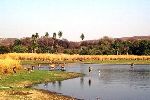
Raj bagh Talao
The second largest amongst the three lakes of Ranthambore National Park and ranking first for its mesmerizing picturesque ness, Raj Bagh Talao is situated adjacent to the Raj Bagh Ruins. The relics from the history and the vivid outlook of the lake together create a marvelous array. The banks of the Raj Bagh Lake embellished with the Raj Bagh Ruins attract bounty of animals. Plenty of the inhabitants of the sanctuary flock around the lake due to the availability of water and vegetation around. That makes the lake a favorite spot to sight wildlife. The Sambhar deer of Ranthambore always occupy the lake front as it grows verdure in abundance. Deer grazing around the lake with egrets enjoying a ride on the deer back creates a really picturesque spectacle. Bounty of prey and water in profusion make Raj Bagh Talao a place frequently visited by wild beasts like tigers. So it turns out to be a prime tiger spotting location for the tourists and wildlife photographers.
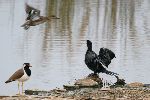
Padam Talao
Padam Talao, the largest lake located in the premises of Ranthambore National Park receives its name from the charming water lilies and elegant lotuses that adorn the Talao during their growing season. Festooned by the Raj Bagh Ruins on one side and the famous Jogi Mahal on the other, this lake is flocked by the animals during early hours of the morning and at the time of dusk. The sighting of the rare ‘Chinkara’ deer is most probable on the banks of this lake. The shallow waters of the Padam Talao enables lake hunters, especially Genghis tigers hunt their prey at ease. A combat between crocodiles and tigers makes a very awe inspiring sight you might witness if you are lucky.
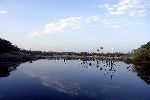
Malik Talao
Of the three lakes situated inside the Ranthambore National Park, Malik Talao is the smallest. Representing the ecosystem, Malik Talao, along with the other two, serves as the source of water and food to the wildlife. Noteworthy for the army of the birds that assembles here everyday, Malik Talao offers a spectacular sight to spot a wide range of birds of all kinds, like king fisher, plovers, herons, moor hen, storks, kites, hawks etc. Kingfisher hunting small fish is a sight of delight. Indian Marsh Crocodiles swimming through and monkeys and tigers drinking lake water can be perceived very clearly from a reasonably close distance here.
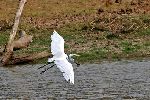
Surwal Lake
Though not inside the National Park, Surwal Lake is one of the favorite tourist destinations around Ranthambore that is noteworthy for its rich flora and fauna. Situated about 25 kilometers from Ranthambore, this lovely lake serves as a home to plenty of migratory birds during winter. The period between November and March is the perfect season to visit Surwal Lake when nature is at its best and birds flock around in bounty. Pelicans, Bar Headed Flamingoes, Demoiselle Cranes, Graylag geese and many more species of the birds fill the ambience with their melodious chirping. The time just before the sunrise is the ideal time to pay a visit to Surwal Lake as the colorful and delicate inhabitants of the lake together create a stunning vista at the dawn. The alluring beauty of this pictorial destination is seasonal as the lake dries up in summer during April and May. Captivating charm of the Surwal Lake: the heaven of the nature lovers rich with the avian fauna attracts myriads of the tourists during winter.

Kachida Valley
Kachida Valley is located near the outskirts of the Ranthambore National Park. This outer region of the park adorned with low hills and rocky outcrops and affluent with flora and fauna is a must visit place for the lovers of wildlife. The majority population of this area is imbibed with panthers and leopards who find refuge to these valleys as they want to avoid conflicts with tigers that rein the main jungle of Ranthambore National Park. Apart from leopards, a huge population of beers and deer also find shelter in Kachida Valley. Tourists can sight a wide variety of species of bears like sloth bears and deer too. The most convenient and ideal mode of transport for visiting Kachida Valley is the forest jeep.
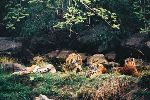
Bakaula
The dense forest of Ranthambore National Park is split into various sections, Bakaula being the one of them. Bakaula region boasts of absolutely thick woods dotted with small water holes and water pools and lush green vegetation. As the dense woods provide an excellent covering with an air-conditioning effect, even in summer, enough water and ample food, the Bakaula terrain of Ranthambore is noteworthy for its extravagant wildlife. This is the most favorite dwelling place of the tigresses having little cubs. Opulent variety of birds and small animals like monkeys and squirrels are found in this coolest vicinity of Ranthambore.

Lakarda & Anantpura
North-Western and Northern regions of Ranthambore are known by the name Lakarda and Anantpura. The most noteworthy feature of this area is its prodigal population of Sloth Bears. Ant hills are found in plenty in this region which are delightfully savored by these bears. Other than ant hills, plenty honeycombs and fresh fruits provide food for them. Apart from the bears, tourists enjoy sighting porcupines, Indian striped Hyenas, monkeys and many other animals. Indian striped Hyenas are quite less in number so they are rarely sighted, but their existence is marked by the pugmarks often discovered in the jungle.
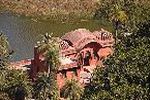
Jogi Mahal
Situated at the foothills of Ranthambore Fort and alongside the well known Padam Talao, Jogi Mahal was originally built by the King of Jaipur to be used as a hunting abode. Several generations of royalties of Jaipur resided at Jogi Mahal when on a hunting vacation. After the decline of Jaipur Empire Jogi Mahal now serves as a guest house for the tourists of Ranthambore. A comfortable stay with all the modern amenities is provided at the Jogi Mahal that basks in the glory and grandeur of lofty past of Jaipur sovereignty.
Tourists can visit the Ranthambore Fort, Raj Bagh Ruins, Padam Talao, and Raj Bagh Talao which are quite close to Jogi Mahal. Padam Talao and Raj Bagh Talao are particularly known for the wild animals sighted here in abundance. Jogi Mahal is especially renowned for the great banyan tree situated nearby which is considered to be the second largest banyan tree in India. Adventure seekers can satisfy their urge by opting for excursions to Bakaula, Nal Ghati, Lakarda and Anantpura etc locations from Jogi Mahal.
Presently the rest house is administered by the forest department of state government. Jogi Mahal is the unique combination of luxury in hermitage, where you can witness the most picturesque locations and experience rare wildlife spotting.

The Ranthambore School of Art
The Ranthambore School of Art was established keeping a goal in mind of advocating and promoting the importance of the conservation and survival of tiger. This school admits the students chiefly from the nearby towns and villages. The teachers of this school often visit the villages with the purpose of spreading awareness about the Project Tiger. The Ranthambore School of Art is situated about 2 kilometers from Sawai Madhopur town and is a must visit destination near the National Park for those who have any appreciation for creativity as well as wild life.
The painters that study at this school of art create paintings with the major theme of the majestic Tigers of Ranthambore. The realistic paintings of these artists portray the glorious Ranthambore tigers in exquisite details like stalking the prey, playing with the cubs, resting at the Raj Bagh Ruins, etc. these paintings present various aspects and moods of Bengal Tiger in minute detail. The Ranthambore School of Art also organizes the exhibition of these tiger paintings and sells them. Many competitions are also held at the school. The efforts of The Ranthambore School of Art are acknowledged and appreciated by various local and countrywide NGOs and animal protection societies.


